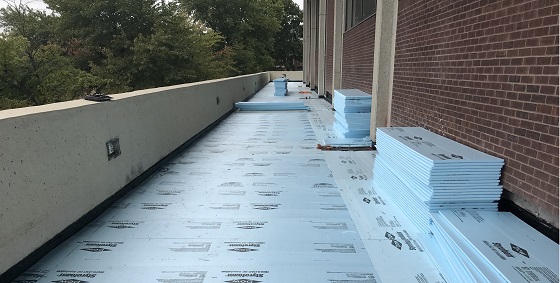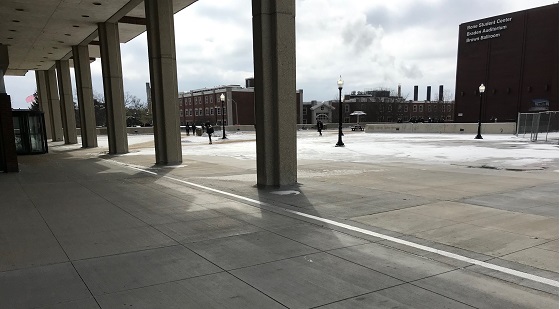Built in 1976, the Milner Library serves as the on-campus library at Illinois State University. With more than 20,000 students, the public university is a key source of learning for thousands each year — with the library at the heart of that mission.
Unfortunately, over the years, the concrete topping slab on the library’s exterior plaza areas had begun showing signs of cracking and spalling. “There was significant leaking into the lower level of the library through the defects in the plaza above,” recalled Scott Haas, branch manager of Western Specialty Contractors in Springfield, Ill. If left unaddressed, those leaks posed potential to threaten the site’s structural integrity.
To fix the problem, the university opted to install and protect a new concrete plaza, with Western hired by the general contractor (GC) for waterproofing. “The GC solicited us for pricing, because masonry restoration and waterproofing is our expertise,” said Haas, whose branch had previously worked with the GC on other projects. That relationship helped build trust and promote positive communication practices.
Time’s Up
Time was of the essence on the Illinois State project, because the GC needed to pour new slabs before the onset of a frigid Midwestern winter. So when Western’s crew arrived in August 2018, they only had a few months to complete 36,000 square feet (3,344.5 m2) of waterproofing.
“After we were done, the GC had to pour a topping slab over everything, and it’s very tough to pour concrete in the winter,” Haas said. “The goal was to give them an adequate window for everything that needed to happen after we were done.”
Considering the project’s size, expedited timetable, and the reality that students were on campus and needed library access, the Western crew had to work in sections. This required constant communication with the GC, and it also allowed many new slabs to be poured when weather was still warm.
“The GC would do demolition, and then we’d do membrane removal,” Haas recalled. “Then, the GC pours a slope slab to correct some elevation, then we put waterproofing on and have it tested, and then the GC would put their topping slab on. Finish and repeat.”
Western was also contracted to perform masonry work, which consisted of removing existing granite stones at the library’s base, as well as two courses of brick above the granite. New waterproofing was applied and terminated behind the masonry, along with new stainless-steel flashing. Crews then reinstalled granite in those sections, along with new brick around the building’s perimeter after the new slab was poured.
Studying the Materials
As for waterproofing, the university and lead architect agreed on a hot-applied solution. “Hot-applied waterproofing is probably the most durable and forgiving system for split slabs,” Haas said. “And it’s monolithic. Generally, they’re preferred.”
Though a hot-applied system does have drawbacks, project leaders kept their eyes on the prize. “Hot-applied waterproofing, by nature, is more labor intensive,” Haas said. “It does have a little bit of a premium cost to it, and it does have an odor. It’s not a solvent odor, but it smells like hot rubber. But in this case, they were looking at this project as a long-term solution to a long-term problem. They were willing to spend to get the most bang for their buck.”
With speed in mind, Western had larger-than-usual crews of between five and nine workers. Given the hot-applied technology, proper safety and personal protective equipment (PPE) choices were paramount.
“Extensive safety measures were in place due to the hot-applied membrane,” Haas said. “Precautions included our workers wearing long-sleeved shirts, protective face shields, and insulated gloves. Crews also had an on-site burn kit, and additional training and inspections were required to ensure safety measures were being followed daily.” Tools had vacuum and water attachments, as per industry standards, with silica dust control procedures used during all silica-generating tasks, such as surface preparation and brick removal.
Beyond safety and PPE gear, perhaps the biggest priority with hot-applied materials was awareness. “You always need to be mindful of where you’re at, and what you’re stepping in,” Haas said. “You want to stay out of material as much as you can, and keep exposed skin and body parts away from points of discharge. We had to have a clear, unobstructed transport path to the application area. And then keep your hands and face away from the material as much as possible to avoid any splatter.”
Working as a Team
After studying their options, the selected system for Western to install outside the library was the HRM 714 liquid-applied waterproofing membrane from W. R. MEADOWS, followed by Dow’s 1-inch (2.5 cm) STYROFOAM HIGHLOAD 60 insulation.
“HRM 714 is a hot-applied rubberized asphalt waterproofing membrane comprised of a 100-percent solids blend of asphalts, synthetic rubber polymers, and filler, formulated to provide toughness with flexibility and low moisture vapor permeance,” said Ashley Fuster, W. R. MEADOWS’ marketing communications coordinator. The system is free of volatile organic compounds (VOCs).

Working section by section, step one was surface preparation, handled by shot blasting each area to achieve the International Concrete Repair Institute’s (ICRI) Concrete Surface Profile (CSP) 3 standard. Shot blasting was performed by a subcontractor, with equipment and material brought up to the plaza level utilizing an on-site ramp.
Once each area was prepared, crew members rolled out MEL-PRIME as the primer, described as a solvent-borne, ready-to-use adhesive for membrane systems. The primer is applied at 250 to 300 square feet per gallon (6.1 to 7.4 m²/L), "so it's a very thin application," Haas said.
From there, the waterproofing material was applied in two passes using 18-inch (45.7 cm) and 24-inch (61.0 cm) squeegees at averages of 90 mils (2,286.0 microns) and 125 mils (5,461.0 microns), respectively, with a layer of reinforcing fabric applied by hand between those two passes. The rubberized asphalt, which came in solid form, was heated into a liquid state in a kettle at 350 °F to 400 °F (176.7–204.4 °C) and then poured onto the concrete while still extremely hot. The crew then spread material evenly over the areas.
“You want to get it on the deck and to the correct mil thickness as soon as you get it,” Haas said. “The cooler the material, the tougher it is to work with. The more it cools, the more it wants to turn back solid. You work with it while it’s hot to get it on the deck, and then you can squeegee and embed your fabric better. As soon as you get the fabric rolled out, you can roll the second layer right in.”
Led by a project manager, superintendent, and site foreman, the crew essentially had their own assembly line. “Everybody has their own task,” Haas said of his crew. “We’d have one guy monitoring the kettle, one or two moving material, one or two on squeegee duty, one or two rolling fabric, and one or two priming ahead.”
A third-party specialist crew from International Leak Detection (ILD) used electronic field vector mapping (EFVM) to locate holes or leaks in the new membrane so that any necessary repairs could be made quickly. “You’re trying to find pinhole breaches in the waterproofing,” Haas said. “You can either apply a little bit of material directly over the breach, or you can take a torch and kind of melt it in. We didn’t on that project due to the open flame risk, so we just applied more waterproofing over the top on those areas.”
The final two steps were the installation of a W. R. MEADOWS protection board and then the Dow insulation, completed after all waterproofing was tested. From there, the GC would apply the new concrete topping slab, and it was on to the next section.
Passing all Tests
With a steady approach and diligent communication, the project was completed within four months and before any Arctic blasts could disrupt the new pours.
“I’m very proud of the guys,” Haas said of his crew. “Everybody worked well together, they had great communication. The project went off without a hitch.”
It’s now been over a year since the plaza work outside Illinois State’s Milner Library was completed. To this point, their work seems to be holding up as expected.
“Everybody was happy at the end of the job, because we finished on time,” Haas said. “With a hot-applied system, it very rarely ever leaks, and I’ve seen no indication that it’s been leaking. It should be watertight for many years.”
